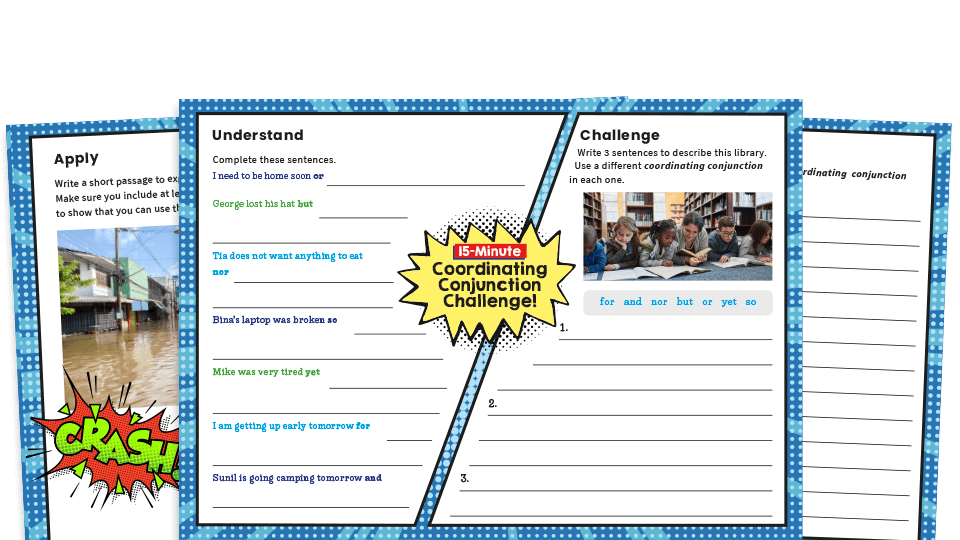Conjunctions are a teaching requirement of the KS2 curriculum. They're an important element of writing. You would soon notice an absence of conjunctions. Writing would be monotonous. Speech would be disjointed. Logic would be hard to follow. Order would be unclear. The passage of time would be disjointed. See?
As soon as you introduce conjunctions, writing becomes a smooth flow of ideas because they create logical, connective links.
Once conjunctions have established the order, you can follow the sequence of events and fully appreciate the narrative or argument that the writer is trying to convey.
You can also add extra ideas and link events with their consequences because conjunctions establish causal relationships too.
If you want to help KS2 children make full use of these vital words, here are some tips to help you...
What is a conjunction?
Just looking at the etymology can help us here: con means together or with; junct means join; and tion means the act or process of.
Therefore, conjunction literally means the act of joining together and that’s what conjunctions do – they are words that connect sentences or clauses, or coordinate words within a clause.
FANBOYS
When it comes to providing coordination, the most obvious is and. For example, it helps to connect words in a list, such as this list of conjunctions, often referred to using the mnemonic FANBOYS: for, and, nor, but, or, so and yet.
For an instant reference showing how to use these conjunctions and many others, why not download our KS2 model sentences resource pack?
This attractively designed resource provides model sentences for over 50 different conjunctions, including the FANBOYS ones, and includes display versions as well as a table-top sheets for a handy guide on how to use them.

Coordinating conjunctions in KS2
Knowing these conjunctions is one thing; being able to use them effectively is quite another. That’s why we also offer our SPaG challenge mat for coordinating conjunctions worksheet pack.
This great resource, aimed at Year 3 pupils, gives them the chance to revise and practise using these pivotal words through a series of worksheets that cement their understanding before getting them to challenge, test, explain and apply their understanding.

To really hammer home the point, display our coordinating conjunctions posters which model the use of the FANBOYS conjunctions around an arresting image.

Subordinating conjunctions in KS2
The other main category of these hard-working words is the subordinating conjunctions. These introduce a subordinate clause and link it to the main clause.
The subordinate clause adds useful information to the main clause but is unable to stand on its own, unlike the main clause.
It is subordinate because it is lower in rank than the main clause. Despite this lowly status, it is highly important and very flexible.
Although it can be placed in the middle of the sentence, the subordinating conjunction can also be placed at the beginning.
For a very graphic illustration of the potential of subordinating conjunctions, see our KS2 display pack. This collection of six posters models their use in sentences connected to an eye-catching image. There are even versions with empty speech bubbles so that pupils can add their own suggestions.

Correlative conjunctions
You probably use these without knowing what they are called. They work in pairs, such as either-or, neither-nor, both-and, whether-or and not only-but also, appearing in different places within the sentence to make them work.
For example:
I can use both coordinating and subordinating conjunctions.
I wasn’t sure whether you wanted to use our resources or spend hours of your precious time making your own.
Causal conjunctions and time conjunctions in KS2
Conjunctions are really useful at expressing the passage of time. Just be a little careful not to confuse time conjunctions with other word classes, such as adverbs and prepositions, that can also perform a similar role.
Before, after, while and when, for example, can all act as time conjunctions, although some can also act as other word classes, such as prepositions, depending on the context.
Causal conjunctions are used to introduce a cause or reason. This group overlaps with subordinate conjunctions such as because and since, owing to their tendency to add information.
Incidentally, conjunctions are not necessarily single words. They can be formed of more than one word, as in even though, so that and rather than.
Conjunction resources for KS2 students
Now that you have the knowledge and resources to teach conjunctions effectively, you can expect your pupils to use them confidently in their writing.
Even so, you will want to give them every opportunity to demonstrate that they can use them properly. For older children, we recommend our Y6 Tricky Grammar Story Starters pack for conjunctions.
This provides a stimulating image to kick-start a discussion before providing opportunities for practising the appropriate use of conjunctions. Ultimately, there is a short writing task through which they can demonstrate their newly-honed skills.

In conclusion, make sure that your pupils know to use a variety of conjunctions. Thanks to the richness of our language, there are usually alternatives for any you wish to use.
After all, there is nothing more soul-destroying than reading a story in which every sentence starts And then …
Sue Drury qualified as a primary teacher in 1999. Teaching pupils from Year 1 to Year 8, she has held a variety of positions including maths and English subject leader, year leader, and assistant headteacher. Sue has mentored students and NQTs, offering guidance and advice using her years of experience. She created many of Plazoom's literacy resources.